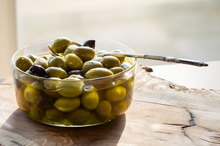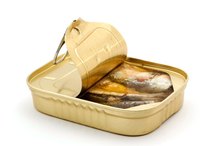What does fact checked mean?
At Healthfully, we strive to deliver objective content that is accurate and up-to-date. Our team periodically reviews articles in order to ensure content quality. The sources cited below consist of evidence from peer-reviewed journals, prominent medical organizations, academic associations, and government data.
- American Heart Association: Know Your Fats
- Mayoclinic.com: Sodium: How to Tame Your Salt Habit Now
- Medline Plus: Iron in Diet
The information contained on this site is for informational purposes only, and should not be used as a substitute for the advice of a professional health care provider. Please check with the appropriate physician regarding health questions and concerns. Although we strive to deliver accurate and up-to-date information, no guarantee to that effect is made.
Nutritional Value of Fried Oysters
Oysters are types of shellfish that are commonly served cold on the half-shell. With this preparation, they are dipped in cocktail sauce or simply eaten without condiments. Fried oysters are altogether different. They are either batter dipped and deep fried or placed in a pan and fried in oil. This variation causes the oysters to have a different nutritional profile.
Calorie Content
When oysters are served on their own, the caloric content is less than when they have breading. One fried oyster contains 55 calories. Be aware that you can easily accumulate calories by eating multiple oysters. This is important if you are trying to watch your weight.
- When oysters are served on their own, the caloric content is less than when they have breading.
- This is important if you are trying to watch your weight.
Fat and Cholesterol
Vitamins in Shrimp
Learn More
Fat comes in the form of polyunsaturated, monounsaturated and saturated. Saturated fat along with cholesterol and trans fat raise cholesterol levels in the body according to the American Heart Association 1. Trans fats are caused from hydrogenated oils which are not found in fried oysters. They do contain fat and cholesterol though. One oyster has just over 3 g of total fat and 26 mg of cholesterol. Of this total fat, only about 3/4 g is saturated. The rest is mono and polyunsaturated which are beneficial types.
- Fat comes in the form of polyunsaturated, monounsaturated and saturated.
- One oyster has just over 3 g of total fat and 26 mg of cholesterol.
Carbs and Protein
Low-carb dieters often add shellfish to their diets because they are low in carbs. This all changes when the shellfish gets breaded, floured and fried. One oyster contains almost 4 g of carbs. This same serving has almost 2 1/2 g of protein. Adding sauces to your oysters will increase the carb content even more.
- Low-carb dieters often add shellfish to their diets because they are low in carbs.
- Adding sauces to your oysters will increase the carb content even more.
Sodium Content
Is Chorizo Bad If You Are on a Diet?
Learn More
One fried oyster contains 141 mg of sodium. This is important information to know when it comes to the well-being of your body. Although sodium is needed for blood volume and nerve impulses, a high amount can be detrimental. According to the University of California San Fransisco, excess sodium in the diet can raise blood pressure and cause fluid retention, resulting in swollen legs. The recommended daily intake is 1,500 mg for people with existing high blood pressure and 2,300 mg for healthy individuals.
- One fried oyster contains 141 mg of sodium.
- According to the University of California San Fransisco, excess sodium in the diet can raise blood pressure and cause fluid retention, resulting in swollen legs.
Miscellaneous
Fried oysters contain a number of miscellaneous nutrients like vitamin C, calcium and iron. Of the three, iron is the most prominent. A single oyster contains 10 percent of the recommended daily intake. Iron is a major contributor to hemoglobin which transports oxygen to muscles and cells. Low iron levels over time can cause a condition known as anemia according to the National Institutes of Health. This in turn can lead to symptoms like lethargy, dizziness and irritability.
- Fried oysters contain a number of miscellaneous nutrients like vitamin C, calcium and iron.
Related Articles
References
- American Heart Association: Know Your Fats
- UCSF Medical Center: Guidelines for a Low Sodium Diet
- Mayoclinic.com: Sodium: How to Tame Your Salt Habit Now
- Medline Plus: Iron in Diet
- Mollusks, oyster, Pacific, raw. FoodData Central. U.S. Department of Agriculture. Published April 1, 2019.
- 7 Reasons to Love Oysters-Even If You Hate Them. Cleveland Clinic. Updated 2016.
- Zinc: Fact Sheet for Health Professionals. National Institutes of Health, Office of Dietary Supplements. Updated 2020.
- 10 Tips: Eat Seafood Twice a Week. ChooseMyPlate U.S. Department of Agriculture.
- Ihn HJ, Kim JA, Lim S, et al. Fermented oyster extract prevents ovariectomy-induced bone loss and suppresses osteoclastogenesis. Nutrients. 2019;11(6). doi:10.3390/nu11061392
- Tischmann L, Drummen M, Gatta-Cherifi B, et al. Effects of a high-protein/moderate-carbohydrate diet on appetite, gut peptides, and endocannabinoids-A preview study. Nutrients. 2019;11(10). doi:10.3390/nu11102269
- Kaufman C. Foods to Fight Iron Deficiency. Academy of Nutrition and Dietetics. Updated 2020.
- Shellfish allergy is not a shell game. American Academy of Asthma, Allergy & Immunology. Updated 2020.
- Risks of Eating Raw Oysters and Clams. Virginia Department of Health. Updated 2018.
- Types of oysters. Berkeley Wellness University of California. Updated 2015.
- Dolaski AM. True or False: Only Eat Oysters in Months That End in 'R'. American Council on Science and Health. Updated 2016.
- Phillips KE, Satchell KJ. Vibrio vulnificus: From oyster colonist to human pathogen. PLoS Pathog. 2017;13(1):e1006053. doi:10.1371/journal.ppat.1006053
- Hassard F, Sharp JH, Taft H, et al. Critical review on the public health impact of norovirus contamination in shellfish and the environment: A UK perspective. Food Environ Virol. 2017;9(2):123–141. doi:10.1007/s12560-017-9279-3
Writer Bio
I am very genuine and magnetic on camera, and have made numerous videos on my own for clients and other organizations that I'm affiliated with. I also have a degree in Sport Management, and multiple certifications to back up my validity. I've also been featured in three different exercise infomercials and had a speaking role in a National Lampoons movie.









